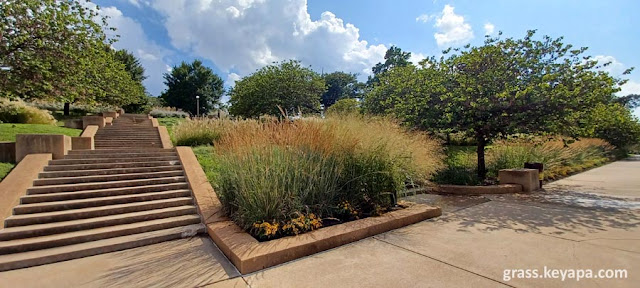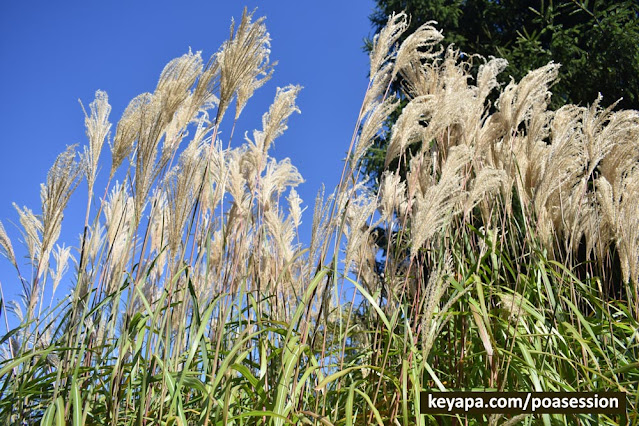 |
| Cynodon dactylon (Bermuda grass) in Parque del Amor, Lima, Peru. The beach is down below a cliff, and you can see the waves as they rush to shore. |
Note: I am by no means an expert at photography, so apologies for any mistaken notions I may have, but here are a few things I've learned.
I am a big fan of macrophotography, and I have been doing it for several years now.
But sometimes I want to show more than just the specimen, especially when the picture I am taking includes scenery that is well known or significant.
In this case, my goal is to have a sharp foreground showing the specimen(s), but with a soft blurry background that does not take away the scenery completely. In order to accomplish this, you need to create something called a shallow depth of field.
 |
| Bromus tectorum (cheatgrass) in foregound of Continental Divide scenery in Rattlesnake Gulch Trail, El Dorado State Park, Colorado, USA. |
Creating this shallow depth of field is more an art than a science, and it involves fiddling with various settings in your DSLR camera, as well as correctly positioning yourself and your subject. This includes:
1. Aperture
This refers to the amount of light that reaches the camera sensor, and the metric it uses is called the f-stop. The lower the f-stop, the greater the amount of light that reaches the sensor, and the shallower the depth of field (the blurrier the background).
For example, an f-stop of 3 means more light gets to the sensor, which creates a shallower depth of field than if the f-stop is 9. So using an f-stop of 3 would get you a blurrier background compared to using an f-stop of 9, all other things being equal.
 |
| Dactyloctenium aegyptium in foreground and our cruise ship in background (in Costa Maya, Mexico) |
2. Focal length
This refers to how wide your angle of view is, and it also affects the magnification. It is measured in millimeters (mm), and the rule of thumb is that the longer the focal length, the greater the magnification, the narrower your field of view, and the shallower the depth of field (the blurrier the background).
So, a focal length setting of 100 mm provides greater magnification, a narrower field of view, and a shallower depth of field than a lens with a focal length of 20 mm.
 |
| Bouteloua dactyloides (Buffalograss) in foreground of Buffalo Bill sculpture in Oakley, Kansas. |
3. Distance between camera and specimen
There are also things you can do beyond just fiddling with your camera settings to create a soft blurry background and a sharply focused subject. The distance you keep between your camera and the actual specimen also makes a big difference.
The smaller the distance between the camera and the specimen, the shallow the depth of field (the blurrier the background).
 |
| Sporobolus michauxianus (formerly Spartina pectinata) near Lower Bluestem Trail, Boulder, CO, USA. |
Putting all these factors together, the golden rule of botanical backgrounding therefore is:
In order to get a shallower depth of field (blurrier and softer background) while maintaining a sharp focus on the specimen, you need a lower f-stop, a higher focal length, and a shorter distance between camera and specimen.
Here's an example of how focal length, aperture, and distance to the specimen can affect the depth of field and how blurry the background gets using the same specimen and background.
In the first pic below, the specimen is Avena barbata, with the Moras Salt Mines in the Sacred Valley of Peru in the background. The f-stop used here is 8, the focal length is 20 mm, and I was standing relatively far away from the specimen when I took the pic. Notice how relatively clear the background is when compared to the actual subject of the photo. This makes the picture too "busy", and detracts from the focus of your photograph, which is the grass in the foreground.
 |
| Avena barbata (?) in the Moras Salt mines in the Sacred Valley of Peru |
Now compare that picture above with the picture below. This is the same specimen, but this time I am using an f-stop of 2.8, a focal length of 100 mm, and I am closer to the specimen. Notice how relatively clear the specimen is, but how blurry the background has become. Normally, I would not want a photo like this when I'm doing botanical backgrounding of my photo (too shallow a depth of field and thus too blurry in back), but it does illustrates how aperture, focal length, and distance to the specimen heavily influences the depth of field and the contrast between subject and background.
It also highlights how much of an art it is trying to get a good optimal mix between a too-clear background that steals focus from the subject, and one that is a completely unrecognizable blur.
 |
| Avena barbata (?) in the Moras Salt mines in the Sacred Valley of Peru |

























